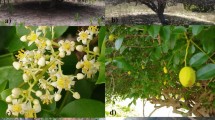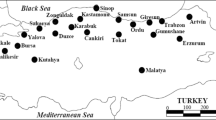Abstract
Recognizing genetic variation and classifying genetic resources are very important in the management and conservation of plant genetic resources. Thymus species (Lamiaceae), a number of which are found in Iran’s flora, comprise herbaceous annual and perennial plants with significance in ethnomedicine. Here, the genetic diversities of twenty T. daenensis and T. eriocalyx ecotypes collected from different regions at the West Azerbaijan province (Iran) were investigated using ISSR molecular markers. Seven out of fifteen ISSR markers, with clear bands, were used. The cluster analysis using NTSYS-PC2 software and genetic structure by STRUCTURE Var 2.3.4 software were performed, and Nei distance was used for UPGMA method. A total number of five hundred and fifty-six polymorphic bands were obtained with an average of 79.42 bands per primer. The average percentage of polymorphic bands was calculated as 95.79% per primer. Eighty polymorphic loci with an average of 11.42 bands per primer were obtained, and P3 and P7 primers showed the highest (0.92) and the lowest (0.64) PIC values, respectively. Also, P2 and P5 primers showed the highest (15.89) and the lowest (5.2) MI values, respectively. Similarities varied from 0.2 (in ecotype TdS vs. ecotype TdPo and TdU1) to 0.67 (in ecotype TdPi vs. ecotype TdMo). The highest distinction between the groups was obtained at the cut point with four groups at a similarity level of 34%. According to the molecular variance analyses, most of the variations were seen within the groups. Finally, P2 and P3 primers are being recommended as efficient markers for genetic diversity analyses in Thymus species.





Similar content being viewed by others
References
Alamdary SBL, Safarnejad A, Nematzadeh GA (2012) Using RAPD marker for genetic diversity assessment of several Thymus species. Iran J Rangelands Forests Plant Breed Gen Res 20:192–201. https://doi.org/10.22092/ijrfpbgr.2013.3477
Alamholo M, Nazeri S (2016) Genetic diversity of Dendrostellera and Daphne genotypes using ISSR markers. Mod Genet J 11(2):313–318. http://dorl.net/dor/20.1001.1.20084439.1395.11.2.16.1
Bagherzadeh F (2009) Genetic diversity assessment of thyme and evaluation of relationship using RAPD marker. MSc thesis. Ferdowsi University. Iran
Belletti P, Monteleone I, Ferrazzini D (2008) A population genetic study in a scattered forest species, wild service tree Sorbus torminalis (L.) crantz, using RAPD markers. Eur J for Res 127:103–114. https://doi.org/10.1007/s10342-007-0187-1
Collard BCY, Mackill DJ (2008) Marker-assisted selection: an approach for precision plant breeding in the twenty-first century. Phil Trans B 363(1491):557–572. https://doi.org/10.1098/rstb.2007.2170
Dalir M, Safarnejad A (2017) Morphological, molecular and phytochemical variation in some thyme genotypes. JMPB 1:41–52. https://doi.org/10.22092/jmpb.2017.113149
Doyle JJ, Doyle JL (1990) A rapid total DNA preparation procedure for fresh plant tissue. Focus 12:13–15
El Hadj Ali IB, Guetat A, Boussaid (2012) Genetic diversity of north African Thymus algeriensis in Tunisia: Population structure and implication for conservation. Dendrobiology 67:67–77. https://bibliotekanauki.pl/articles/41188
Elsherbeny E, Eldemerdash ES, Salama Y, Zoelfakar M (2019) Genetic diversity among Thymus spp. using RAPD and ISSR markers. Egypt J Desert Res 69(2):91–106. https://doi.org/10.21608/ejdr.2021.17138.1044
Hadian J, Bigdeloo M, Nazeri V, Khadivi-Khub A (2014) Assessment of genetic and chemical variability in Thymus caramanicus. Mol Biol Rep 41:3201–3210. https://doi.org/10.1007/s11033-014-3180-z
Hartl DL, Jones EW (2005) DNA structure and DNA manipulation in genetics: analysis of genes and genomes. Sudbury: Jones and Bartlett Pub. Ch 2:36–855th edn.
He F, Kang D, Ren Y, Qu LJ, Zhen Y, Gu H (2007) Genetic diversity of the natural populations of Arabidopsis thaliana in China. Heredity 99:423–431. https://doi.org/10.1038/sj.hdy.6801020
Joshi SP, Gupta VS, Aggarwal RK, Ranjekar PK, Brar DS (2000) Genetic diversity and phylogenetic relationship as revealed by inter-simple sequence repeat (ISSR) polymorphism in the genus Oryza. Theor Appl Genet 100:1311–1320. https://doi.org/10.1007/s001220051440
Kim M, Moon J, Ch, Kim S, Sowndhararajan K (2020) Morphological, chemical, and genetic characteristics of Korean native Thyme Bak-Ri-Hyang (Thymus quinquecostatus Celak). Antibiotics 9(289):1–16. https://doi.org/10.3390/antibiotics9060289
Kumar GP, Pathania P, Goyal N, Gupta N, Parimalan R, Radhamani J, Gomashe SS, Kadirvel P, Rajkumar S (2023) Genetic Diversity and Population Structure Analysis to Construct a Core Collection from Safflower (Carthamus tinctorius L.) germplasm through SSR markers. Agriculture 13(836):1–13. https://doi.org/10.3390/agriculture13040836
Liu LW, Zhao LP, Gong YQ, Wang MX, Chen LM, Yang JL, Wang Y, Yu FM, Wang LZ (2008) DNA fingerprinting and genetic diversity analysis of late-bolting radish cultivars with RAPD, ISSR and SRAP markers. Sci Hortic 116:240–247. https://doi.org/10.1016/j.scienta.2007.12.011
Murashige T, Skoog F (1962) A revised medium for rapid growth and bioassays with tobacco tissue cultures. Plant Physiol 15:473–497. https://doi.org/10.1111/j.1399-3054.1962.tb08052.x
Narasimhan S, Padmesh P, Nair GM (2006) Assessment of genetic diversity in Coscinium fenestratum. Biol Plant 50:111–113. https://doi.org/10.1007/s10535-005-0082-x
Nybom H (2004) Comparison of different nuclear DNA markers for estimating intraspecific genetic diversity in plants. Mol Ecol 13:1143–1155. https://doi.org/10.1111/j.1365-294x.2004.02141.x
Nybom H, Bartish IV (2000) Effects of life history traits and sampling strategies on genetic diversity estimates obtained with RAPD markers in plants. Evol Syst 3:293–114. https://doi.org/10.1078/1433-8319-00006
Peakall R, Smouse PE (2006) GenAIEx 6: genetic analysis in Excel. Population genetic software for teaching and research. Mol Ecol Notes 6:288–295. https://doi.org/10.1111/j.1471-8286.2005.01155.x
Rahimmalek M, Bahreininejad B, Khorrami M, Sayed TBE (2009) Genetic variability and geographic differentiation in Thymus daenensiss subsp. daenensis, an endangered medicinal plant, as revealed by inter simple sequence repeat (ISSR) markers. Biochem Genet 47:831–842. https://doi.org/10.1007/s10528-009-9281-z
Ramanatha Rao V, Hodgkin T (2002) Genetic diversity and conservation and utilization of plant genetic resources. Planr Cell Tissue Organ Cult 68:1–19. https://doi.org/10.1023/A:1013359015812
Rohlf FJ (2000) NTSYS-pc numerical taxanomy and multivariate analysis system. Version 1.8. Exeter Publications Setauket, New York
Saeidi H, Sayed Tabatabaei BE, Rahimmalek M, Talebi-Badaf M, Rahiminejad MR (2008) Genetic diversity and gene-pool subdivisions of diploid D-genome Aegilops tauschii Coss. (Poaceae) in Iran as revealed by AFLP. Genet Resour Crop Evol 55:1231–1238. https://doi.org/10.1007/s10722-008-9323-0
Sarfaraz D, Rahimmalek M, Saeidi Gh, Sabzalian MR (2020) Genetic relations among and within wild and cultivated Thymus species based on morphological and molecular markers. 3 Biotech 10(7):289. https://doi.org/10.1007/s13205-020-02274-6
Schulmann AH (2007) Molecular markers to assess genetic diversity. Euphytica 158(3):313–321. https://doi.org/10.1007/s10681-006-9282-5
Sostarica I, Liberb Z, Grdisac M, Marind PD, Stevanovica ZD, Satovicc Z (2012) Genetic diversity and relationships among species of the genus Thymus L. (section Serpyllum). Flora 207: 654–661. https://doi.org/10.1016/j.flora.2012.06.018
Talebi M, Rahimmalek M, Norouzi M (2015) Genetic diversity of Thymus daenensis subsp. daenensis using SRAP markers. Biologia 70(4):453–459. https://doi.org/10.1515/biolog-2015-0059
Trindade H, Costa MM, Lima SB, Pedro LG, Figueiredo AC, Barroso JG (2009) A combined approach using RAPD, ISSR and volatile analysis for the characterization of Thymus caespititius from Flores, Corvo and Graciosa islands (Azores, Portugal). Biochem Syst Ecol 37:670–677. https://doi.org/10.1016/j.bse.2009.10.006
Witono JR, Kondo K (2006) Genetic analysis of some species of pinanga (Palmae) by using ISSR markers. Berita Biologi 8:19–26
Yousefi V, Najaphy A, Zebarjadi A, Safari H (2015) Molecular characterization of thymus species using ISSR markers. J Anim Plant Sci 25 (4)
Acknowledgements
The authors acknowledge Biotechnology Department at Bu-Ali Sina University, Hamedan, Iran, for laboratory facilities.
Funding
The authors declare that no funds, grants, or other support were received during the preparation of this manuscript.
Author information
Authors and Affiliations
Contributions
The experiments were designed and performed by MA and AT. The manuscript was prepared, revised, proofread and approved by JS, MA and AT.
Corresponding author
Ethics declarations
Conflict of interest
The authors have no conflicts of interest to declare.
Consent for publication
Not applicable.
Additional information
Publisher’s Note
Springer Nature remains neutral with regard to jurisdictional claims in published maps and institutional affiliations.
Electronic supplementary material
Below is the link to the electronic supplementary material.
Rights and permissions
Springer Nature or its licensor (e.g. a society or other partner) holds exclusive rights to this article under a publishing agreement with the author(s) or other rightsholder(s); author self-archiving of the accepted manuscript version of this article is solely governed by the terms of such publishing agreement and applicable law.
About this article
Cite this article
Alamholo, M., Tarinejad, A. & Soltani, J. Genetic diversity analyses of Thymus daenensis and Thymus eriocalyx ecotypes using ISSR molecular marker. Biologia 79, 1267–1276 (2024). https://doi.org/10.1007/s11756-024-01613-9
Received:
Accepted:
Published:
Issue Date:
DOI: https://doi.org/10.1007/s11756-024-01613-9




